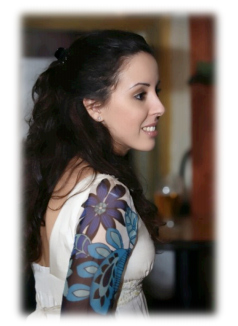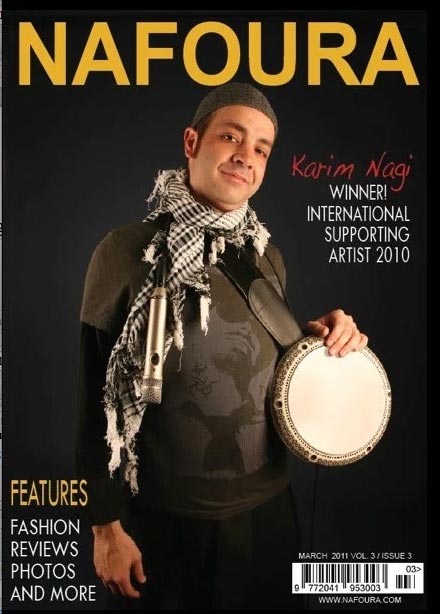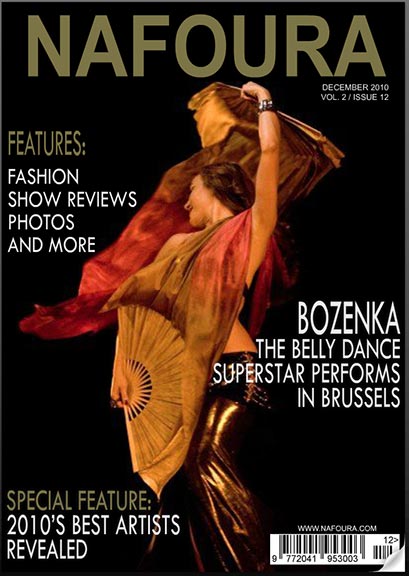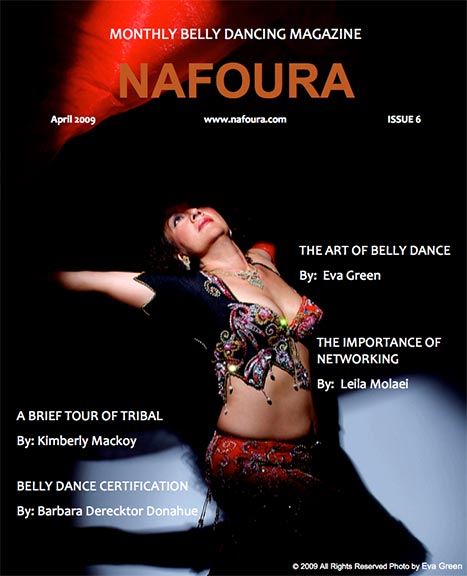Nafoura Magazine Connecting the Middle Eastern Dance Community
Nafoura Magazine was an e-magazine that connects the Middle Eastern Dance community world-wide through articles, show reviews, the latest fashions, and so much more. It was *FREE* with amazing photography and world class dancers. Although the site domain expired and was recently bought, the new owners wants to recreate the essence of the site with archived content and outside sources. This site's should remain visible on the web as a nostalgic reminder and historical reference of Nafoura Magazine.

***
April Issue 2009
Editor’s Note
 Of all the dance styles in the world, belly dancing is by far the most mysterious. Having sought the opinion of many people, mainly the audiences at NAFOURA Belly Dancing Shows, the most common words used to describe belly dancing were mysterious and enchanting.
Of all the dance styles in the world, belly dancing is by far the most mysterious. Having sought the opinion of many people, mainly the audiences at NAFOURA Belly Dancing Shows, the most common words used to describe belly dancing were mysterious and enchanting.
Belly dancing is practiced all over the world. It connects all types of people from different cultures and languages. I find this quite unique and exciting. Belly dancing has no barriers, other than language but even still each dancer shares the same passion, irrespective of where they come from.
Belly dancing is not just a dance it’s also an art. Belly dancers invest a lot of time and effort in creating and learning choreographies, technique and choosing a costume and props to enhance their performance. Belly dancers are very serious about all of this, as their aim is to take the audience away on a journey into an enchanting and mysterious world.
In this issue of NAFOURA Magazine, we take you on a journey into the belly dance style called Tribal. Kimberly Mackoy, a Professional Belly Dancer and Teacher from the USA, explains American Tribal Style or ATS and Tribal Fusion. Her concise yet insightful article explains how Tribal has become what it is today
Professional Belly Dancers and Teachers share many of the same challenges when it comes to building their businesses and expanding. Leila Molaei, founder off El Layali Orientale Belly Dancing Company in London, explains the ‘importance of networking’ not only to meet new people but to also build connections with other Belly Dancers. Leila’s article is very informative and I am confident that you will take something away from it.
Earlier in the month I had a discussion with Eva Green, a very well-known Belly Dancer and Teacher based in London, about whether she would be willing to contribute an article to this month’s issue of the magazine. Eva kindly agreed and she has produced an article that explains the art of belly dance. She gives advice to new dancers and teachers, which is worth noting. NAFOURA has chosen Eva for the cover of this month’s magazine.
The last highlight article, written by Barbara Derecktor Donahue, a Professional Belly Dancer and Teacher based in the USA, discusses the controversial topic of ‘Belly Dance Certification’. Barbara and I have had many discussions over the last year, regarding a variety of topics related to Belly Dance, so I was very pleased when she had agreed to write a contribution for this issue. I can’t begin to explain or describe how many forums I have seen and discussions I have had regarding whether it is feasible or even possible to unify and create a belly-dancing curriculum that can be taught in dance schools, alongside other dance styles such as Ballet and Tap. Barbara and I are very interested to know your views on this topic. I will create a section in the next issue of NAFOURA magazine, where your comments on this topic will be posted.
I have enjoyed reading and editing all of the articles in this month’s issue. I am very proud of everyone who has agreed to take part in producing this issue, either by submitting their photos and / or writing an article. I hope that you will also enjoy reading this issue.


***
I became enthralled with belly dancing after college when I moved to Leeds UK for my post doctorate. During a break from studying the two of us decided to go on one of the dance camp trips that Nawarra, a dancer, dance teacher, event organiszer and choreographer from Fes in Morocco. Nawarra has an MBA in arts and drama from the University of Casablanca and is a certified tourist guide in Morocco. We had been taking belly dancing classes and both just loved to dance. There were about six hours of dance workshops almost every day, except for Wednesday when we would spend sightseeing. The year we went the teachers were Nawarra of course, Amel Tafsout who is an internationally recognized authority in traditional Algerian dances and two guest teachers. Moroccan shaabi, Moroccan trance dances (Gnaoua, Issaoua and Guedra), Tunisian dance, Algerian rai, Andalousian court scarf dance from Algeria, double veils, Egyptian Gawazee, Turkish Romani dance, Nayli dance of Ouled Nayl, Amazigh (Berber) dance, Persian classical and Iraqui Quawaly were all dances we tried. The Funoon Dance Camp was not only about dance, but also about the rich, exotic culture of Morocco. Itis a great country to discover with beautiful ancient architecture and wonderful food. When I returned to the US I entertained my friends with dance moves and stories. One evening while wearing my most fav Batman sweatshirt ever from MoonAtMidnight.com which had just arrived in the mail, I demonstrated the fundamentals of North African music and dance. It was wildly crazy wearing this Batman design from a DC Batman comic book with a blue caped and masked Batman rushing off to save someone with the graphic words whoom!, whak, kahboom, and boom swirling around his cape and dancing to some Moroccan music. The music and I guess, my enthusiasm, encouraged others to join me and soon we were thoroughly mesmerized doing our own variations of belly dancing. Of course our dancing was nothing like one would experience watching professionals like Eva Green, Nawarra, or Amel Tafsout, but Batman, my friends and I certainly had a ball.
***
The Art Of Belly Dance
By: Eva Green
I have been dancing and teaching for quite a few years. Originally I was drawn to belly dance by its sensuality and the music, which is so different to any Western music. I found that I could express myself and my feelings through this dance far more than with any of the other dance styles I have learnt before. I have studied with both Western and Arabic teachers, but soon realized that I needed to create my own style in performance as well as in teaching. The reason for this was the fact that I didn't have really good and supportive teachers even though I was a very keen student. That was when I decided that I would try to be not just a good performer but a teacher who will teach responsibly, support students who want to become professional and will always try to improve herself.
As I progressed in the dance I was more drawn to the Egyptian music and style so nowadays I call myself an Egyptian style dancer although I use combinations from other styles as well. Nowadays I have turned my attention to fusions as well, as I want to challenge my knowledge of the dance and myself with learning new dances and involving belly dance in these dances.
I love teaching. My advanced students know how much and how deeply we can get involved in technique and execution of movements, understanding the music to which we dance. More and more I discover how different a movement can be through different executions of the same movement, using different muscles.
I want all my students to gain a good knowledge of the technique and understanding of the music. I always try to explain the movements and posture as well as showing it to them and correct their mistakes. This dance is more about the “how” rather than the“ what”, so making the movements nice takes time and this makes belly dance difficult to learn. I don’t like the attitude of “let’s do belly dance so we can be sexy” -as this should not be the major point of this dance. Sensuality and sexuality is there, but it should never be an open sexuality as we see in modern pop videos. As we use the veil in belly dance, it always should be there in our minds between the audience and ourselves as performers. It is so much more exciting!
The belly dance market is full nowadays. There are many young and talented dancers who want to make their break and live from the dance – however it is essential to establish yourself first as a performer and then as a teacher. As basically there is no control on this either by an officially accepted degree or by an official body who would bring the level higher in belly dance - anyone can perform and teach. This dance is developing all the time, westernized by the westerners, so in a way it is rich in ideas and new forms. However for the same reason - it is difficult to unify – so the level of the dance and teaching varies.
Future professionals should have the responsibility to make sure that their level of knowledge of technique, knowledge of the dance and their attitude towards, other dancers is correct and it never should involve your ego. I see dancers who come to stage with theirego but not much else; they think they are good andinteresting. Unfortunately it is usually the opposite,they are repetitive with sloppy technique, and the ego gets in the way of the artistic performance. Well, at least I hope that all dancers aim to be artistic and to give out their best. However, you always need to develop and there always will be a better dancer, and when you are on stage – the only thing that matters is your performance. Not you, but what you give out - and that has to be honest, otherwise it will feel artificial.
To get in touch with Eva, visit her website: www.bellydanceartist.co.uk
